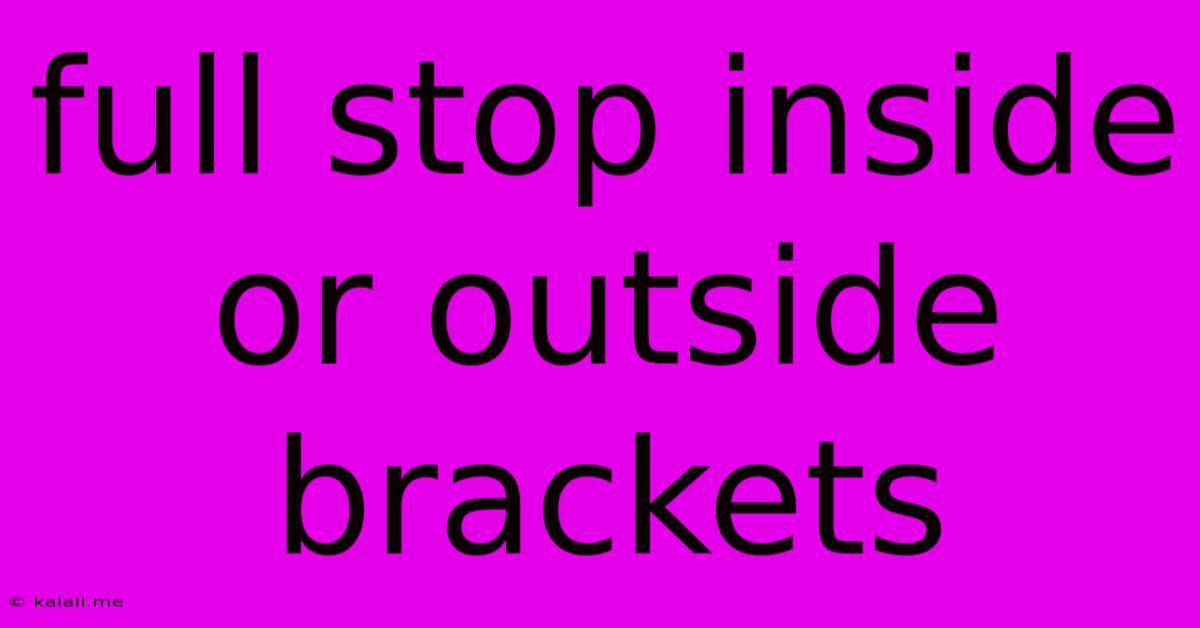Full Stop Inside Or Outside Brackets
Kalali
May 21, 2025 · 3 min read

Table of Contents
Full Stop Inside or Outside Brackets? A Definitive Guide to Punctuation
The placement of a full stop (period) in relation to brackets is a common punctuation query. Many writers struggle to remember the correct rule, leading to inconsistent and sometimes confusing text. This guide will clarify the rules and provide clear examples to help you confidently punctuate your writing. Understanding this seemingly small detail significantly improves readability and professionalism.
The Basic Rule: Punctuation Follows the Grammatical Unit
The key to understanding this is to determine what grammatical unit the punctuation belongs to. The full stop should always be placed inside the brackets if the bracketed material is a complete sentence. Conversely, it should be placed outside the brackets if the bracketed material is not a complete sentence.
Scenario 1: Complete Sentence Within Brackets
If the text within the brackets forms a complete sentence—containing a subject and a verb and expressing a complete thought—the full stop goes inside the closing bracket.
Example: "The meeting was adjourned. (The agenda had been completed.)"
In this case, "(The agenda had been completed.)" is a complete sentence. Therefore, the full stop is placed inside the closing bracket.
Scenario 2: Incomplete Sentence Within Brackets
If the bracketed information is not a complete sentence—it’s a phrase, clause, or just a single word—the full stop is placed outside the closing bracket.
Example: "The cat sat on the mat (a particularly fluffy one)."
Here, "(a particularly fluffy one)" is not a complete sentence. The full stop belongs to the main sentence and is placed outside the bracket.
More Complex Scenarios & Additional Considerations
Let's explore some more complex situations:
- Brackets within Brackets: If you have nested brackets, the inner bracket's punctuation follows its own grammatical unit, while the outer bracket's punctuation follows its own. This requires careful attention to detail.
Example: "He said, 'I agree with the proposal (especially point three, which addresses the concerns raised by the committee [as outlined in their report]).'"
- Multiple Sentences Within Brackets: If multiple sentences are enclosed within brackets, each sentence within the brackets will have its own internal punctuation, with the final sentence's full stop remaining inside the closing bracket.
Example: "The report was comprehensive. (The findings were detailed. The analysis was thorough.) The conclusions were clear."
- Questions and Exclamations Within Brackets: If the bracketed material is a question or exclamation, the question mark or exclamation point remains inside the closing bracket.
Example: "Did you see that? (It was amazing!)"
Why This Matters: Readability and Professionalism
Correct punctuation, even seemingly minor details like the placement of a full stop, demonstrates attention to detail and enhances the readability of your writing. Consistent punctuation ensures clarity and professionalism, contributing to a positive reader experience and reinforcing your credibility as a writer. Ignoring these rules can lead to ambiguity and confusion.
Conclusion: Practice Makes Perfect
Mastering the placement of full stops in relation to brackets might seem insignificant, but consistent application showcases a thorough understanding of grammar and punctuation. By consistently applying these rules, you’ll enhance the clarity and professionalism of your writing. Practice reading through your writing and checking for these small, but crucial details, and soon it will become second nature.
Latest Posts
Latest Posts
-
How Many Tea Bags For A Pot Of Tea
May 21, 2025
-
Expression For Something A Person Likes Or Excels In
May 21, 2025
-
Why Does My Car Vibrate At High Speeds
May 21, 2025
-
What Does Dark Mean In Tall Dark And Handsome
May 21, 2025
-
How Long After Grouting Can You Shower
May 21, 2025
Related Post
Thank you for visiting our website which covers about Full Stop Inside Or Outside Brackets . We hope the information provided has been useful to you. Feel free to contact us if you have any questions or need further assistance. See you next time and don't miss to bookmark.